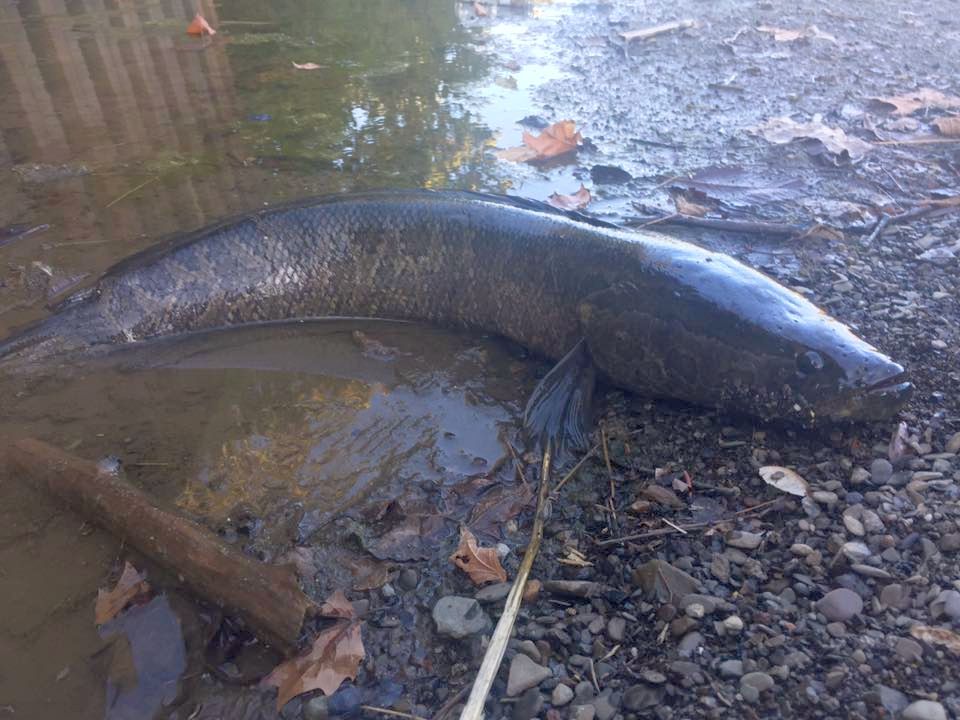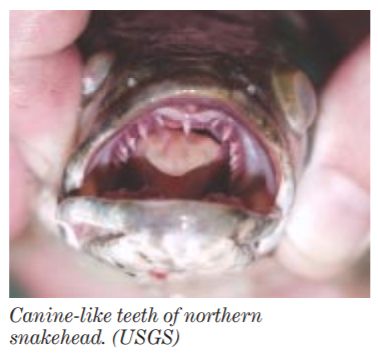
Lance Mroz knew this fish was trouble as soon as he pulled it from the river. Anglers had been warned for years to watch out for this invasive alien species but it had never been seen in western Pennsylvania waters — not until Lance caught it in the Monongahela River at Duck Hollow on 26 September 2019.
Northern snakeheads (Channa argus) are predatory fish native to China, Russia and the Koreas. They prefer shallow stagnant freshwater and can survive in low oxygen locations because they can breathe the air. In fact they can live out of water for days where it’s moist and cool and are known to wriggle overland from pond to pond, earning them the nickname “walking fish.”
This top-level predator eats crustaceans, amphibians and other fish and can double its population in only 15 months. If you find one, watch out! They look like this.
All Snakeheads are distinguished by their torpedo shaped body, long dorsal and anal fins without spines, and toothed jaws. Northern Snakeheads are typically distinguished by a flattened, pointy head with long lower jaws.
They have teeth …

… and they can get really big! According to Wikipedia, a record 19.9 pound northern snakehead was caught — actually shot at night with a bow and arrow — at Mattawoman Creek in Charles County, Maryland in May 2018.
How did they get here? People release them. They’ve been kept in aquariums or raised on fish farms in the past, but it’s illegal to keep a live one now in North America. Not everyone knows this.
The first encounter with northern snakeheads in the U.S. did not go well. A breeding population was found in a pond in Crofton, Maryland in 2002. Officials were so worried about this species that they drained the pond and poisoned three adjacent ponds to kill every fish. A man later admitted to releasing an adult pair in the original pond, but the fish was out of the bag. It already had spread in the watershed.
Since then northern snakeheads have been found in Virginia, Florida, New York, Pennsylvania, Massachusetts, California, North Carolina, Arkansas, and B.C, Canada. New isolated discoveries always begin with someone releasing a fish. If the fish become established they spread throughout the watershed. When deemed appropriate, wildlife officials may poison newly infested ponds and kill all fish.
Fortunately Lance Mroz knew what to do. He identified the fish, killed it, froze it and reported it to the PA Fish and Boat Commission. If you ever catch one,
- Identify it: It resembles two native fish, but not closely. Use this USFW Factsheet to Identify the Northern Snakehead.
- DO NOT RELEASE THE FISH.
- Kill it. This video from the Maryland Department of Natural Resources has drawings that show how to kill this fish.
- Freeze it. The fish agency will want to see it.
- Notify the local fish agency. In Pennsylvania that’s the PA Fish and Boat Commission (PFBC) at 610-847-2442 or via email.
The PA Fish and Boat Commission confirmed today, 30 September, that it’s indeed a northern snakehead.
Thanks to Lance Mroz for posting his catch in the Duck Hollow Facebook group. Now we know what to look for and what to do when we find it.
(fish photo courtesy of Lance E. Mroz, Jr., teeth photo from USFW factsheet)
Additional resources:
- Wikipedia northern snakehead
- US Fish and Wildlife Northern Snakehead Factsheet
- August 2019 Trib-Live article by Mary Ann Thomas: Watch out for invasive Northern Snakehead fish.
- 30 September 2019 Trib-Live article by Mary Ann Thomas: Invasive northern snakehead fish confirmed caught in Monongahela River.
- PA Fish Commission northern snakehead ID poster here.